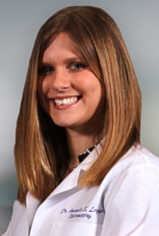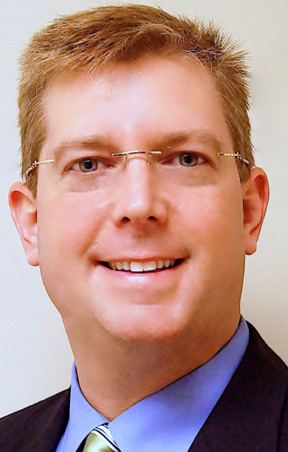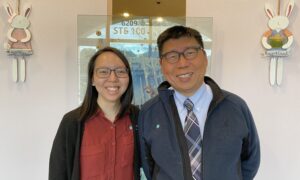Sponsored Content

By ROB Editors
Jan. 9, 2019
The demand for medical eyecare services is growing at a pace nearly three times the growth of comprehensive eye exams. Based on disease prevalence, AMD in particular is an area of tremendous opportunity. AMD is more prevalent than glaucoma and diabetic retinopathy combined—and by the year 2050, it is estimated to double. This is inspiring a growing number of optometrists to commit to making AMD a greater focus in their practices to improve patient outcomes as well as practice revenue.
Here ROB talks with three optometrists who grew their AMD practices and helped protect the vision of countless patients by investing in the AdaptDx to perform functional testing that enables them to detect early AMD up to three years before it becomes clinically evident.
What first sparked your interest in the AdaptDx and how did this evolve into your decision to buy it?
 Amanda S. Legge, OD, Wyomissing Optometric Center: “Our practice had the first commercial AdaptDx in the country. The solid research of the relationship between dark adaptation and its ability to aid diagnosis and management of AMD made this a no-brainer to purchase. Even better, this instrument is unique in that it can diagnose AMD up to three years before signs present in my clinical examination.”
Amanda S. Legge, OD, Wyomissing Optometric Center: “Our practice had the first commercial AdaptDx in the country. The solid research of the relationship between dark adaptation and its ability to aid diagnosis and management of AMD made this a no-brainer to purchase. Even better, this instrument is unique in that it can diagnose AMD up to three years before signs present in my clinical examination.”
 Scott Schachter, OD, Ocular Surface Academy: “My purchase of the AdaptDx was a happy accident. My OCT wasn’t functioning, so I signed a contract to have it replaced, but at the last minute I was able to instead have it repaired. But this happened after I had allocated the funds under Section 179, so I had to scramble to spend the money. I had read a few articles about the clinical benefits of dark adaptation testing and checked with some colleagues who highly endorsed the technology. Once I confirmed the clinical benefits, I looked into financial feasibility. What I found was that it pays better than a visual field yet takes less time. In addition, many of my patients would qualify for the test.”
Scott Schachter, OD, Ocular Surface Academy: “My purchase of the AdaptDx was a happy accident. My OCT wasn’t functioning, so I signed a contract to have it replaced, but at the last minute I was able to instead have it repaired. But this happened after I had allocated the funds under Section 179, so I had to scramble to spend the money. I had read a few articles about the clinical benefits of dark adaptation testing and checked with some colleagues who highly endorsed the technology. Once I confirmed the clinical benefits, I looked into financial feasibility. What I found was that it pays better than a visual field yet takes less time. In addition, many of my patients would qualify for the test.”
 Harry W. Landsaw, Landsaw Eyecare: “It clicked for me when I looked at the number of glaucoma patients in my practice. There appeared to be a lot more of them than there were confirmed AMD patients. I know AMD is more prevalent, and my practice is full of older patients, so naturally I started to wonder how many patients I might be missing.”
Harry W. Landsaw, Landsaw Eyecare: “It clicked for me when I looked at the number of glaucoma patients in my practice. There appeared to be a lot more of them than there were confirmed AMD patients. I know AMD is more prevalent, and my practice is full of older patients, so naturally I started to wonder how many patients I might be missing.”
What were your ROI goals when you first purchased the AdaptDx?
Dr. Legge: “Our general goal was to make sure that we had enough patients in our demographic to cover the monthly payment of the instrument. We far exceed that goal each month. Surprisingly, not all of the patients we test are over age 50. By asking the right questions, you may discover several young patients with night vision complaints that warrant testing.”
Dr. Schachter: “I have a broad mix of patients of all ages in my practice, including plenty of Medicare. For two weeks, I tracked how many patients I would have performed the test on and realized it would more than support my financing on the unit.”
Other Articles to Explore
Did the device live up to your expectations in the first six months?
Dr. Legge: “I discovered early on that it is extremely reliable and repeatable, more so than visual field testing for glaucoma patients. Furthermore, as my trust in the accuracy and reliability of the instrument’s results grew, I began to utilize it more frequently because it gives such a unique marker for AMD. I believe this is equivalent to, and in some way surpasses, the reliability of diagnosing and managing glaucoma with visual field testing.”
Dr. Schachter: “Yes, totally. One thing I did to ensure this was to change my questionnaire to always ask, “is your night vision poor or getting worse?” This provides lots of patients and allows you to screen for AMD with dark adaptation testing using ICD-10 code H53.62 for acquired night blindness. The CPT Code 92284 is used for dark adaptation, and the average national reimbursement is $64.08.”
Dr. Landsaw: “We have a small practice, so we set a goal to test three patients per day, and we are almost there after fewer than six months with the device. Already, we tripled the number of patients we are treating for AMD.”
How has the AdaptDx performed for your practice —from an ROI perspective?
Dr. Legge: “We run the AdaptDx every day, multiple times a day, both for pre-appointed patients and for screening patients with night vision complaints. It has far exceeded our expectations for ROI from the reimbursement of the test itself and also increased optical sales of Rx sunglasses and blue-blocking lens recommendations to patients with abnormal Rod Intercept times.”
Dr. Schachter: “We perform approximately 100 tests per 1,000 refractions, which provides the immediate payback. But when you add in the revenue generated from preventive eyewear, OCT, additional monitoring and supplements, the benefits are significant.”
How has the AdaptDx performed for your practice —from a clinical perspective?
Dr. Legge: “From a patient education perspective, the test makes AMD a solid diagnosis instead of a conversation of clinical drusen that may or may not be the start of early AMD.”
Dr. Schachter: “Our practice motto is optimize versus rehabilitate. We are about wellness. At another practice, a patient’s disease might be missed for years. With the AdaptDx, we find it early—and that’s a big win.”
How do you decide who to test with the AdaptDx?
Dr. Legge: “All patients with any clinically evident risk factors for AMD are tested. In this way, we are diagnosing isolated drusen unrelated to AMD from true early AMD patients. And all patients with night vision complaints are also tested with or without signs of drusen/RPE changes. Over time, we have become more aggressive with testing patients with night vision complaints and it has markedly increased the number of subclinical AMD patients in our practice who we now can educate early and monitor more closely.”
Dr. Landsaw: “I’m testing everyone who presents with a night vision complaint. As a result, I see as many as 30-40 percent of those patients fail the Rapid Test. So, in my heart, I truly believe this needs to be like visual fields. If you believe you need that, then you need an AdaptDx. We need to make a difference in AMD, and now we can.”
Harry W. Landsaw, OD, is the owner of Landsaw Eyecare in Tavernier, Fla. He has been a MacuLogix AdaptDx owner since June 2018.
Amanda S. Legge, OD, is the owner of Wyomissing Optometric Center, with locations in Wyomissing, Douglassville, Myerstown and Reading, Penn. She has been a MacuLogix AdaptDx owner since 2015.
Scott Schachter, OD, is the founder of the Ocular Surface Academy and a Vision Source Administrator. He has been a MacuLogix AdaptDx owner since 2017.

























